
Home - Search - Browse - Alphabetic Index: 0- 1- 2- 3- 4- 5- 6- 7- 8- 9
A- B- C- D- E- F- G- H- I- J- K- L- M- N- O- P- Q- R- S- T- U- V- W- X- Y- Z
Sokol-KV2
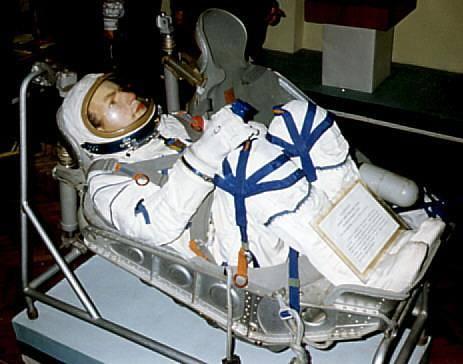
Sokol-K Suit at Baik
Credit: © Mark Wade
Status: operational 1990.
The Sokol KV-2 ("Falcon") crew rescue suit was first worn in the Soyuz T-2 spacecraft on 5 June, 1980, and continued in use into the 21st Century for crews flying aboard Soyuz spacecraft today during launch and descent. Each suit was connected to an on-board life support system in the capsule which supplied oxygen, electrical power, suit ventilation and water for the cooling garment worn underneath. The suit was designed to not impede the astronaut during flight in a pressurized cabin and to support the astronaut's life in case of cabin depressurization. The soft suit consisted of two layer enclosures, an outer restraint layer of white nylon canvas with royal blue trim, and an internal pressure bladder of rubber and rubberized material. The integral helmet had a soft hood and a hinged plastic visor. In comparison to the Sokol K, the KV-2 had two zippers in place of the lacing on the front opening; the helmet and visor dimensions were increased; the pressure regulator, located at the side on the Sokol K suit, was integrated with the inlet valve and was placed at the center of the body under the helmet. In case of cockpit depressurization, pure oxygen was supplied to the suit. The pressure regulator provided two suit pressure modes - 400 hPa (main mode) and 270 hPa (back-up).
Other external features of the suit were the blue anodized aluminum visor flange; trussed sleeves with adjustable articulating cables in the upper arm; webbed belt lashings; a pressure gauge on the left sleeve covered by a protective gasket; a mirror on an elasticized band on the right wrist; detachable gloves; the double-V-front zip closure; a lace-up crotch with triangular packet; anodized aluminum umbilical inlets on the torso for electrical, air and coolant lines; the pressure equalization valve on the chest; a support sling running from chest to back by means of webbed belts and metal clips; adjustable webbed straps, marked in mm, attached to metal rings on the side seams and along the crotch; pleated knees; two utility pockets on each leg; and integral soled shoes.
The suit was developed in 1973-1979. It was designed to support a suited astronaut for up to 30 hours in a pressurized cabin and two hours in an unpressurized one. Ventilating air was provided at 150 l/minute and oxygen at 20 l/minute in pressurized operation. Up to the end of 2002, 220 flight models and 63 test and training suits had been manufactured.
Each suit was tailor-made to fit individual crew members. In the Soyuz spacecraft they reclined in Kazbek-U seats which had custom-fitted molded liners.
The wearer climbed into the suit via the zippered front opening; the suit was then sealed by gathering folds of the space suit cloth and wrapping rubber bands around them. The suit was one-piece, including the helmet, but excluding the gloves which were put on separately.
The Sokol was not comfortable to walk around in due to its internal wiring and lack of ventilation (the wearers had to carry their own ventilator to avoid overheating). It was essentially designed to fit in the Kazbek seat, on one's back with the knees up. The helmet's soft cover was folded back when the wearer was upright; it could only fit over the head when lying in the seat.
After manufacture of a individually-tailored flight suit, the crew member occupied the Kazbek seat with the custom-fitted couch liner and sat in the flight posture under positive pressure for two hours. The suit was readjusted as a result of this first fit test. The same procedure was then repeated in a vacuum chamber, with simulation of oxygen supply to the suit helmet. Finally the suit fit was checked again at Baikonur prior to the mission, and the crew member would spend some time in the suit in the reentry capsule of the actual spacecraft that would take them to orbit. On the day of the flight, the final check was accomplished by Zvezda personnel during suiting up for the lift-off, and even then last-minute adjustments could be made.
During cosmonaut and crew training at the Gagarin Cosmonaut Training Center in Star City, the crew members also wore training versions of their suits during sessions in the Soyuz simulator, and in wilderness survival and ocean recovery training.
Zvezda ground support test equipment and fixtures were used in all preflight testing. The suits were ventilated with air supplied from cosmodrome ground sources during fit checks at Baikonur. Air conditioning was provided by this ground support equipment during fit checks. The suits were then connected to portable ventilation units for the trip to the spacecraft. These included a fan that brought ambient air to the suit, batteries for power, and cooling via a block of ice inserted prior to use. The same simple portable units had been used since Voshkod-2 in 1965.
Family: Space Suits. Country: Russia. Agency: Zvezda Design Bureau.
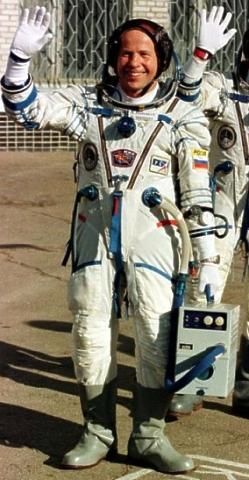 | Sokol -K1V Suit |
 | Sokol-K Suit, Mir we Credit: © Mark Wade |
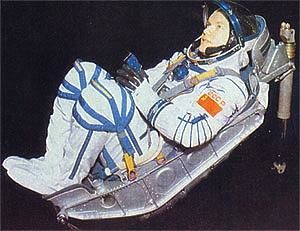 | Sokol-K Suit, Seat Credit: © Mark Wade |
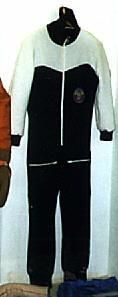 | Soyuz Heavy Jumper Credit: © Mark Wade |
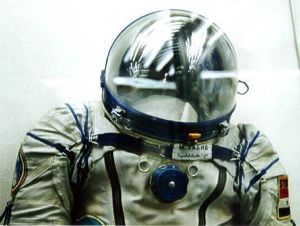 | Soyuz TM-3 Soyuz TM-3 - space suit worn by Syrian Cosmonaut Faris. Credit: © Thanassis Vembos |
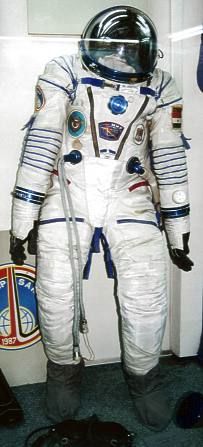 | Soyuz TM-3 Soyuz TM-3 - space suit worn by Syrian Cosmonaut Faris. Credit: © Thanassis Vembos |
Back to top of page
Home - Search - Browse - Alphabetic Index: 0- 1- 2- 3- 4- 5- 6- 7- 8- 9
A- B- C- D- E- F- G- H- I- J- K- L- M- N- O- P- Q- R- S- T- U- V- W- X- Y- Z
© 1997-2019 Mark Wade - Contact
© / Conditions for Use